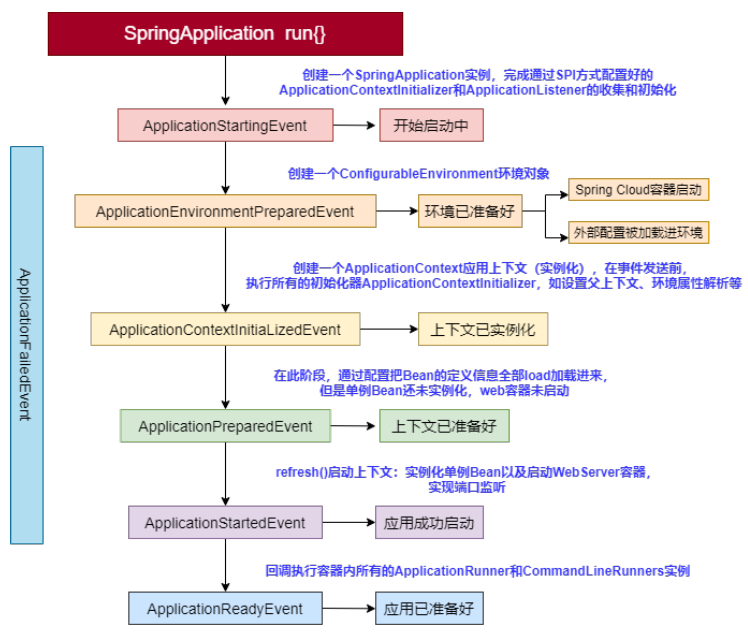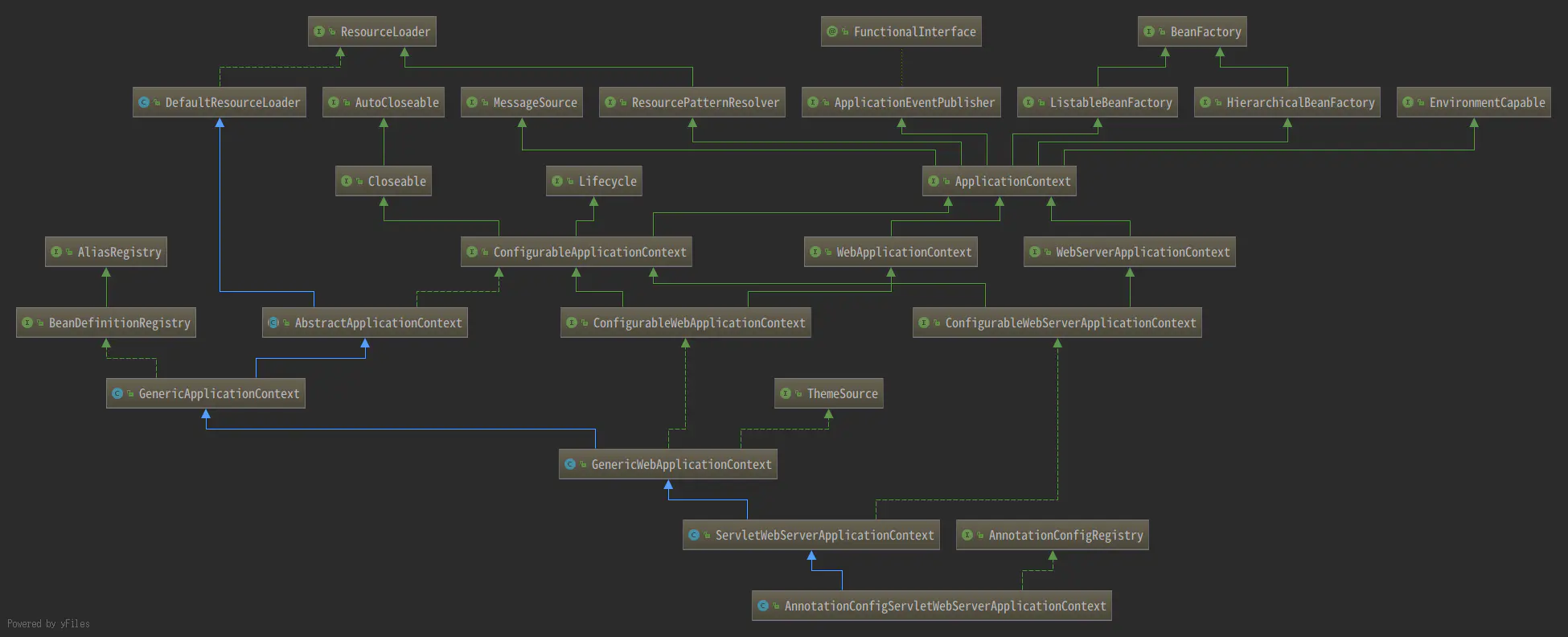springBoot 启动过程分析
一、springBoot生命周期伴随的事件

springBoot的启动过程就是通过事件机制驱动的,可以通过监听这些事件做一些定制化的功能。因为springBoot已经成为众多中间件和框架的基础,所以了解其整个生命周期是很必要的,接下来就从源码的角度去分析它的整个启动流程。
二、源码分析
1、实例化SpringApplication
public static ConfigurableApplicationContext run(Class<?>[] primarySources, String[] args) { return new SpringApplication(primarySources).run(args); }
public SpringApplication(ResourceLoader resourceLoader, Class<?>... primarySources) { this.resourceLoader = resourceLoader; Assert.notNull(primarySources, "PrimarySources must not be null"); this.primarySources = new LinkedHashSet<>(Arrays.asList(primarySources)); this.webApplicationType = WebApplicationType.deduceFromClasspath(); setInitializers((Collection) getSpringFactoriesInstances( ApplicationContextInitializer.class)); setListeners((Collection) getSpringFactoriesInstances(ApplicationListener.class)); this.mainApplicationClass = deduceMainApplicationClass(); }
构造方法里主要做了四件事:
(1)根据classpath下是否存在某些特定类来确定应用的类型,包括:REACTIVE、SERVLET和NONE三种类型,其中REACTIVE、SERVLET会以WEB应用的形式启动,NONE则会在应用执行完毕后结束进程
(2)利用SpringFactoriesLoader自动加载spring.factories文件中配置的 ApplicationContextInitializer,ApplicationContextInitializer原本是Spring框架Context模块下的一个接口,Spring Boot内部提供了一些该接口的实现类,使得我们有机会对ApplicationContext做一些特定的初始化工作
(3)利用SpringFactoriesLoader自动加载spring.factories文件中配置的 ApplicationListener,ApplicationListener同样是Context模块下的接口,Spring Boot内部提供了一些该接口的实现类,使得我们有机会在监听到某些应用事件发生时做一些特定的工作。
(4)根据main方法执行堆栈确定应用的主引导类,即Spring Boot项目自带的XXApplication类
2、进入到真正的run方法中
public ConfigurableApplicationContext run(String... args) { StopWatch stopWatch = new StopWatch(); stopWatch.start(); ConfigurableApplicationContext context = null; Collection<SpringBootExceptionReporter> exceptionReporters = new ArrayList<>(); configureHeadlessProperty();
//在这实例化SpringApplicationRunListener SpringApplicationRunListeners listeners = getRunListeners(args);
//发布ApplicationStartingEvent事件 listeners.starting(); try { ApplicationArguments applicationArguments = new DefaultApplicationArguments( args);
//发布ApplicationEnvironmentPreparedEvent事件 ConfigurableEnvironment environment = prepareEnvironment(listeners, applicationArguments); configureIgnoreBeanInfo(environment); Banner printedBanner = printBanner(environment); context = createApplicationContext(); exceptionReporters = getSpringFactoriesInstances( SpringBootExceptionReporter.class, new Class[] { ConfigurableApplicationContext.class }, context);
/**
* 发布ApplicationContextInitializedEvent事件
* load(context)方法加载所有bean定义信息(BeanDefinition)
* 发布ApplicationPreparedEvent事件
**/
prepareContext(context, environment, listeners, applicationArguments, printedBanner); refreshContext(context); afterRefresh(context, applicationArguments); stopWatch.stop(); if (this.logStartupInfo) { new StartupInfoLogger(this.mainApplicationClass) .logStarted(getApplicationLog(), stopWatch); }
//发布ApplicationStartedEvent事件 listeners.started(context); callRunners(context, applicationArguments); } catch (Throwable ex) {
//发布ApplicationFailedEvent事件 handleRunFailure(context, ex, exceptionReporters, listeners); throw new IllegalStateException(ex); } try {
//发布ApplicationReadyEvent事件 listeners.running(context); } catch (Throwable ex) {
//发布ApplicationFailedEvent事件 handleRunFailure(context, ex, exceptionReporters, null); throw new IllegalStateException(ex); } return context; }
(1)listeners.starting() —— 发布ApplicationStartingEvent事件
public void starting() { this.initialMulticaster.multicastEvent( new ApplicationStartingEvent(this.application, this.args)); }
监听此事件的监听器:
LoggingApplicationListener:@since 2.0.0。对日志系统抽象LoggingSystem执行实例化以及初始化之前的操作,默认使用的是基于Logback的LogbackLoggingSystem
BackgroundPreinitializer:启动一个后台进行对一些类进行预热。如ValidationInitializer、JacksonInitializer...,因为这些组件有第一次惩罚的特点(并且首次初始化均还比较耗时),所以使用后台线程先预热效果更佳
DelegatingApplicationListener:它监听的是ApplicationEvent,而实际上只会ApplicationEnvironmentPreparedEvent到达时生效,所以此处忽略
LiquibaseServiceLocatorApplicationListener:略
(2)prepareEnvironment(listeners,applicationArguments) ——发布ApplicationEnvironmentPreparedEvent事件
Environment代表着应用的上下文环境,主要是解析获取profile和properties。
private ConfigurableEnvironment prepareEnvironment( SpringApplicationRunListeners listeners, ApplicationArguments applicationArguments) { // Create and configure the environment ConfigurableEnvironment environment = getOrCreateEnvironment(); ——(1) configureEnvironment(environment, applicationArguments.getSourceArgs()); ——(2) listeners.environmentPrepared(environment); ——(3) bindToSpringApplication(environment); ——(4) if (!this.isCustomEnvironment) { environment = new EnvironmentConverter(getClassLoader()) .convertEnvironmentIfNecessary(environment, deduceEnvironmentClass()); } ConfigurationPropertySources.attach(environment); ——(5) return environment; }
主要做以下几件事情:
1)根据webApplicationType创建不同的Environment,web环境下创建了StandardServletEnvironment
2)将应用启动时候传入的args设置到Environment中去
3)发布ApplicationEnvironmentPreparedEvent事件,告诉之前获取的所有监听器,应用的上下文环境已经准备好了,这个时候监听器主要做的事情就是加载application.properties以及profile文件
4)将获取到的environment中的spring.main配置绑定到SpringApplication的source中
5)将创建好的Environment里获取到的MutablePropertySources再设置到configurationProperties属性值里面去,并且作为第一个元素。
(3)createApplicationContext()
终于到了创建应用上下文的时候了,前面都是在做准备工作,准备工作做好了,开始创建Spring中最核心的容器ApplicationContext了。
protected ConfigurableApplicationContext createApplicationContext() { Class<?> contextClass = this.applicationContextClass; if (contextClass == null) { try { switch (this.webApplicationType) { case SERVLET: contextClass = Class.forName(DEFAULT_SERVLET_WEB_CONTEXT_CLASS); ——(1) break; case REACTIVE: contextClass = Class.forName(DEFAULT_REACTIVE_WEB_CONTEXT_CLASS); break; default: contextClass = Class.forName(DEFAULT_CONTEXT_CLASS); } } catch (ClassNotFoundException ex) { throw new IllegalStateException( "Unable create a default ApplicationContext, " + "please specify an ApplicationContextClass", ex); } } return (ConfigurableApplicationContext) BeanUtils.instantiateClass(contextClass); ——(2) }
主要做了两件事:
1)加载ApplicationContext的class对象,如果是web应用加载的就是"org.springframework.boot.web.servlet.context.AnnotationConfigServletWebServerApplicationContext",这里说下Class.forName和ClassLoader的区别:
Class.forName除了将类的.class文件加载到jvm外,还会对类进行解释,执行static方法。
2)对类—AnnotationConfigServletWebServerApplicationContext进行初始化
public AnnotationConfigServletWebServerApplicationContext() { this.reader = new AnnotatedBeanDefinitionReader(this); this.scanner = new ClassPathBeanDefinitionScanner(this); }
进行初始化时会创建AnnotatedBeanDefinitionReader reader和ClassPathBeanDefinitionScanner scaner,扫描所有带@Component、@Service、@Repository、@Controller等注解的类,注册到容器中。
同时也会创建上下文的beanFactory,实际类型为DefaultListableBeanFactory。如下是其类图关系:

初始化子类之前必须先初始化其父类,在父类GenericApplicationContext中创建beanFactory:
public GenericApplicationContext() { this.beanFactory = new DefaultListableBeanFactory(); }
(4)prepareContext()
将之前获取到的Environment、listeners、applicationArguments以及printBanner都设置到applicationContext中去,并发布ApplicationContextInitializedEvent事件和ApplicationPreparedEvent事件。
private void prepareContext(ConfigurableApplicationContext context, ConfigurableEnvironment environment, SpringApplicationRunListeners listeners, ApplicationArguments applicationArguments, Banner printedBanner) { context.setEnvironment(environment); postProcessApplicationContext(context); applyInitializers(context);
//在此处发布ApplicationContextInitializedEvent listeners.contextPrepared(context); if (this.logStartupInfo) { logStartupInfo(context.getParent() == null); logStartupProfileInfo(context); } // Add boot specific singleton beans ConfigurableListableBeanFactory beanFactory = context.getBeanFactory(); beanFactory.registerSingleton("springApplicationArguments", applicationArguments); if (printedBanner != null) { beanFactory.registerSingleton("springBootBanner", printedBanner); } if (beanFactory instanceof DefaultListableBeanFactory) { ((DefaultListableBeanFactory) beanFactory) .setAllowBeanDefinitionOverriding(this.allowBeanDefinitionOverriding); } // Load the sources Set<Object> sources = getAllSources(); Assert.notEmpty(sources, "Sources must not be empty"); load(context, sources.toArray(new Object[0]));
//在此处发布ApplicationPreparedEvent listeners.contextLoaded(context); }





